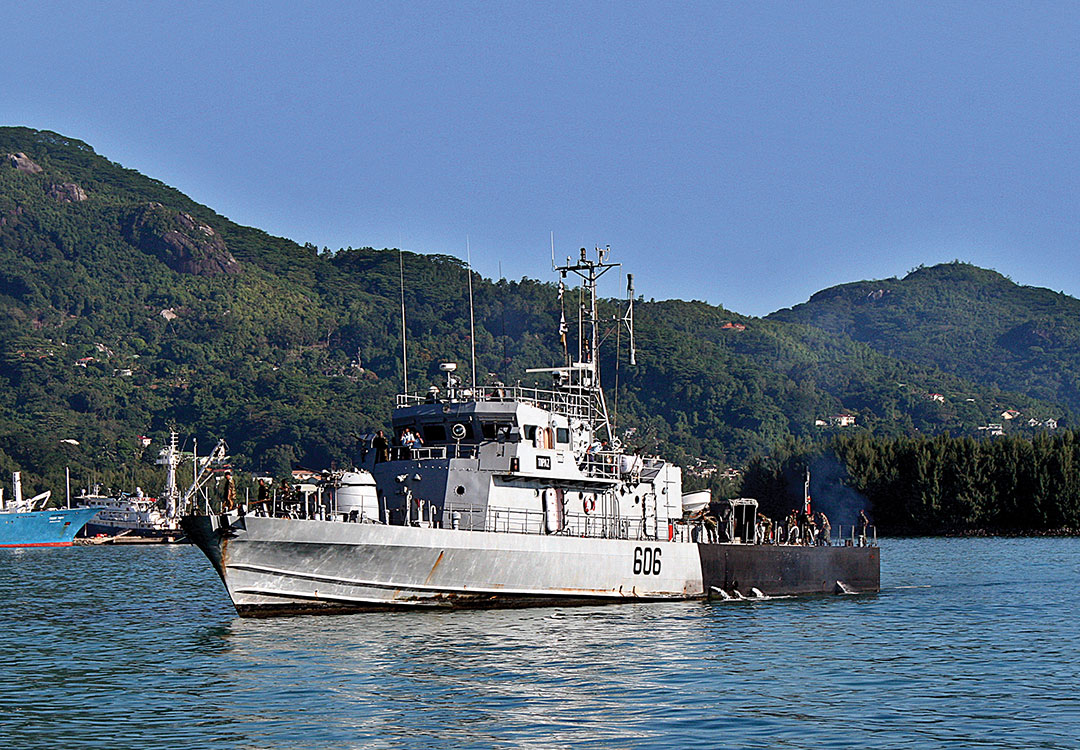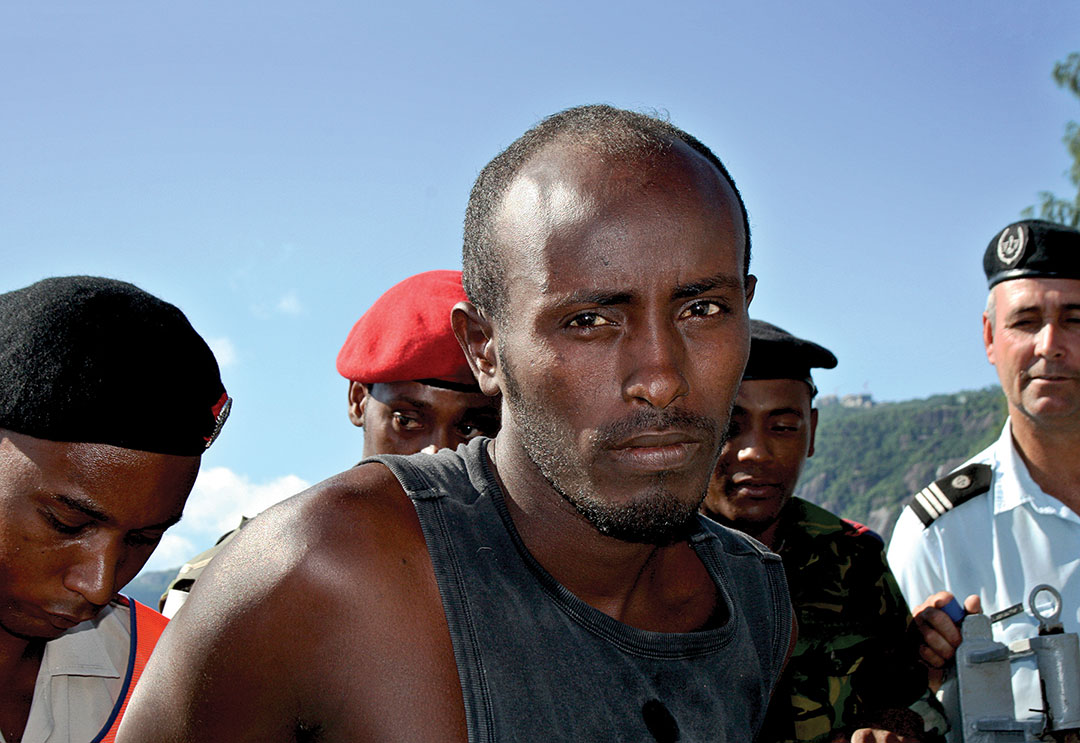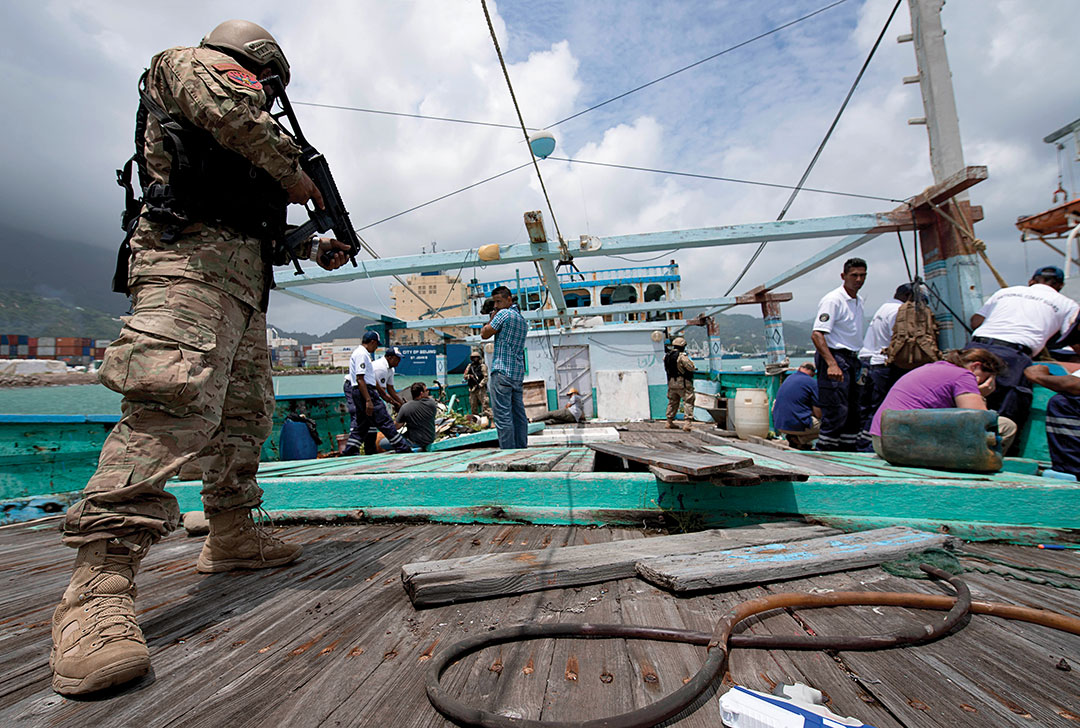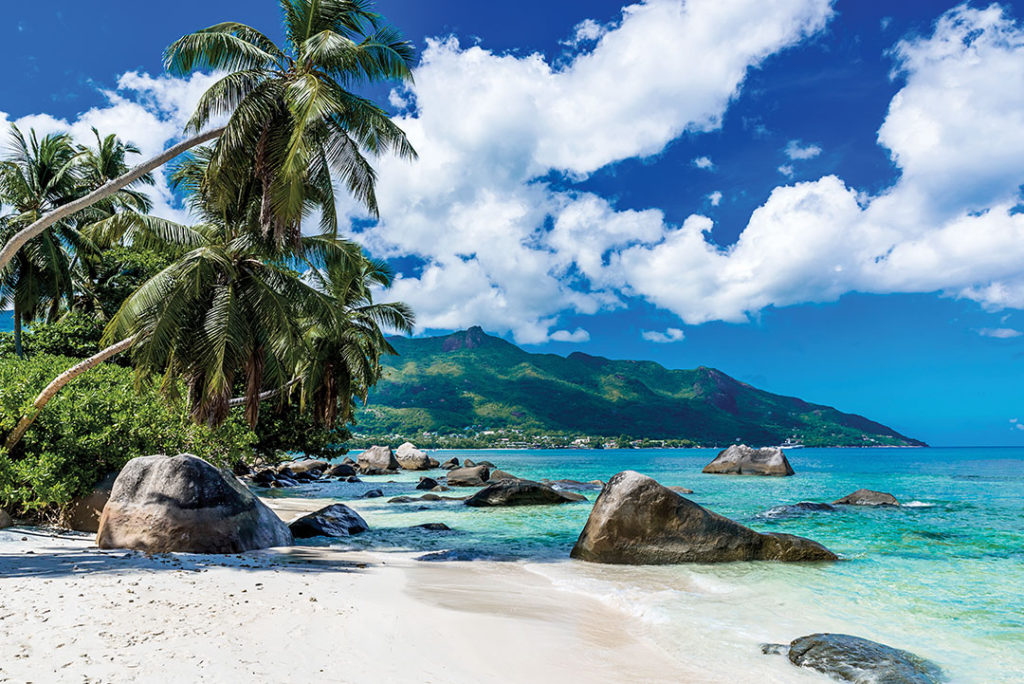Africa’s Smallest Nation Is Setting a Standard for Safe, Sustainable Seas
ADF STAFF
As the six Seychellois crew members of the fishing boat Galate slept at sea southeast of Mahé Island, they should have had little more to fear than awakening to another busy day of hauling in tuna from the Indian Ocean.
Armed bandits, however, were stalking the waters. International naval patrols had pushed pirates hundreds of miles from the Somali coast and the Gulf of Aden. Now some of those pirates had their sights on the fishermen.
About 2 a.m. on March 30, 2010, nine Somali pirates, recently in possession of an Iranian fishing dhow and its 21 crew members, sought to add the Galate to their haul. The pirates had captured the Iranian craft four days earlier, according to a report in afrol News.
By the time the Somali pirates boarded the Galate, pirates already had attacked and captured crews of the Serenity, Indian Ocean Explorer and Alakrana. Then-President James Michel was determined that no more of his people were going to be bargaining chips for Somali-based pirates.
Michel ordered the Seychelles Coast Guard vessel Topaz to intercept the dhow, which was towing the Galate, and prevent it from reaching Somalia. If the Topaz failed, another prolonged and dangerous ordeal to secure the crew members’ release was almost sure to follow.
With help from European Union Maritime Patrol Aircraft, the Topaz found the dhow and fired warning shots. Then, the Topaz fired on the dhow’s engine, disabling the boat and setting it ablaze. The pirates, Iranians and Seychellois fishermen jumped into the sea and were rescued. As it returned home, the Topaz had to repel another pirate attack, firing on and sinking a skiff and a mother ship. Another skiff escaped.
“We all remember the pain and uncertainty when our compatriots on board the Serenity, Indian Ocean Explorer and Alakrana were being held hostage by pirates last year,” Michel said after the Galate incident, afrol News reported. “We were determined that such incidents do not repeat themselves, and it was important that the vessel not be allowed to reach Somalia.”
In the years since the Galate incident, the Seychelles has been leading the way in the prosecution and imprisonment of East African pirates, bolstering its small Coast Guard, forging agreements and alliances with foreign powers, and ensuring the preservation and protection of its vast maritime domain. The work is paying off. Africa’s smallest nation is setting a standard for the continent.
A VAST DOMAIN
The Seychelles is a 115-island archipelago with a combined land area of 455 square kilometers, but it must protect an exclusive economic zone at sea of 1,336,559 square kilometers — an area larger than South Africa. The Seychelles and its 90,000 residents have a stake in maritime concerns that greatly eclipses those of nations many times its size and population.

As piracy and other maritime threats increased in the Indian Ocean, the Seychelles benefited from forward-thinking leaders willing to engage with international partners. The nation’s diminutive size and geography also helped, said Dr. Ian Ralby, adjunct professor of maritime law and security at the Africa Center for Strategic Studies.
“In some ways their size gives them the advantage of agility,” Ralby told ADF. “It’s a lot easier to change things and change approaches when you’re 90,000 people than when you are 200 million people.”
However, the Seychelles’ size also magnifies the effects of piracy and other threats. Threats to the fishing industry or tourism are felt acutely nationwide. Ignoring the problem is not an option.
The Seychelles also benefits from another unique feature. Dr. Christian Bueger, in a paper co-authored with Anders Wivel in May 2018, poses this question: “How can it be that a country with such limited human and financial resources becomes recognized as a major diplomatic facilitator and as one of the agenda setters in ocean governance?”
The secret, Bueger told ADF, is embedded in the nation’s ethnic and cultural history.
A UNIQUE FORM OF DIPLOMACY
The Seychelles does not have an indigenous culture or population. In fact, it had no population at all until the 1770s, when French planters arrived, bringing East African slaves with them. The nation’s modern population includes the descendants of French, African and British settlers, as well as African, Indian, Chinese and Middle Eastern traders who lived on three main islands — mostly on Mahé, and to a lesser extent on Praslin and La Digue.
Bueger and Wivel wrote that slaves were traded as individuals, not groups or families, so their cultures were not preserved. With the eventual influx of other nationalities from the East and West, the Seychelles became a Creole country. This mixture of cultures, without a strong devotion to any one of them, makes the Seychelles adept at what Bueger calls “Creole diplomacy.”

“In Creole diplomacy, you have many friends, no enemies, and you speak with everyone, and you can be very pragmatic in terms of making things work rather than having a lot of ideological or historical problems involved,” said Bueger, a professor of international relations at the University of Copenhagen. “So pragmatism, openness toward all sorts of cultures and other nations — this is a Creole principle; it’s how Creole culture works.”
The Seychellois government cooperates with a diverse range of nations and organizations on maritime issues. It has worked with international organizations to combat maritime crime, participated in international naval exercises and struck bilateral deals with foreign nations to bolster its training and interdiction capacity through the acquisition of sea and air assets. Some examples:
- In 2014, the European Union (EU) donated flight planning and imagery-analysis software to the Seychelles and taught officers to use it. The system helps the Air Force monitor the maritime domain and effectively analyze radar, video and infrared images, defenceWeb reported. This capacity helps provide admissible evidence in piracy prosecutions.
- In 2015, the Seychelles became the first regional nation to chair the Contact Group on Piracy off the Coast of Somalia, serving for two years. Participants coordinate political, military and nongovernmental efforts to combat East African piracy and ensure that pirates are brought to justice. Nearly 80 nations and several international organizations participate.
- German Sailors on the FGS Bayern, the nation’s flagship vessel in the EU multinational Operation Atalanta patrol fleet, trained the Seychelles Marine Police Unit in 2016 on boarding, securing landing zones and fighting onboard fires, defenceWeb reported.
- In January 2018, the Seychelles was the host nation for Cutlass Express, U.S. Africa Command’s East African naval exercise. Participating nations tested their capacity to combat trafficking, piracy, illegal fishing, and to conduct search-and-rescue operations. Participants came from Australia, Canada, Comoros, Denmark, Djibouti, France, Kenya, Madagascar, Mauritius, Mozambique, New Zealand, the Seychelles, Somalia, South Africa, the Netherlands, Turkey and the United States.
- The Seychelles People’s Defence Forces (SPDF) and the Indian Army joined in February 2018 for an eight-day exercise called Lamitye, the Creole word for friendship. SPDF Lt. Col. Jean Attala told Seychelles News Agency that the biennial exercise, started in 2001, strengthens the two forces’ counterinsurgency, counterterrorism and anti-piracy operations. It involved SPDF, Coast Guard and Air Force personnel.
A LEADER IN PROSECUTIONS
One arena in which the Seychelles has excelled is in its willingness to prosecute pirates caught attacking ships off the coast of Somalia and beyond. As naval forces began to strike back against pirates in the Gulf of Aden and Indian Ocean, they engaged in “catch and release” because participating nations were not willing to prosecute pirates in their home countries.
“To address this, the international community worked towards a solution whereby international navies would arrest suspects, but then hand them over to regional countries for prosecution,” Bueger and Wivel wrote.
Kenya stepped up first, and then the Seychelles agreed to prosecute pirates and soon became the primary regional state to handle the cases. They have tried dozens of cases representing more than 100 suspects and have handled several appeals cases as well. All along the way, the country remained steadfast in its devotion to the rule of law.

participate in boarding drills during exercise Cutlass Express 2018. PETTY OFFICER 3RD CLASS FORD WILLIAMS/U.S. NAVY
At first, Ralby said, the Seychelles didn’t have sufficient jurisdiction to prosecute cases originating on the high seas or laws to address “attempted piracy.” They also navigated a steep learning curve on rules of evidence such as proving suspects are older than 18 or addressing questions of their citizenship. “As legal issues arose, they actually amended their laws in order to be able to handle the cases appropriately,” Ralby said. “So they have some of the world’s leading expertise at this point in terms of the mechanics of actually taking a piracy case from wherever — anywhere on the high seas — to trial and all the way through to prosecution, conviction, appeal and the eventual imprisonment.”
The tiny nation, on islands in the middle of the Indian Ocean, saw the benefit of re-establishing the rule of law in the maritime domain. It also saw the benefit of making the sea sustainable, as well as safe.
“If the only incentive for maritime security is to protect the state against threats, you have a very depressing and unending problem, in that you are spending a lot of money on stopping something that will always be coming,” Ralby said. “There will always be new threats; there will always be new maritime security challenges.”
SEEING THE BIG MARITIME PICTURE
The Seychelles, perhaps more so than any other African nation, knows the value and fragility of its sea-based economy. Its revenues derive chiefly from the fishing and tourism industries, and crime at sea imperils that commerce. As nations strive to be more aware of the maritime domain, Ralby said the Seychelles works tirelessly to protect and cultivate it as a source of wealth and prosperity.
The Seychelles has a fishing traceability policy that allows global consumers to see the origination of tuna caught by Seychellois fishing boats. This market transparency adds value to legal catches and discourages illegal fishing.
The country also has embarked on a novel way of preserving its maritime domain while retiring sovereign debt. The financing arrangement, known as “debt for dolphins,” has the Seychelles setting aside vast swaths of its maritime domain for preservation in exchange for funding that retires national debt.
Early in 2018, The Nature Conservancy offered to buy about $22 million of Seychelles’ debt. In exchange, the country would designate a third of its marine area as protected, Reuters reported. The first 210,000-square-kilometer conservation area would limit fishing, oil exploration and development in fragile habitats and allow them under certain conditions in the rest of the area. An additional 200,000-square-kilometer area was to have different restrictions.
The Seychelles has committed to protecting up to 30 percent of its marine domain through a comprehensive marine spatial plan. The plan will protect species and habitats, build coastal resilience against climate change, and preserve economic opportunities in tourism and fishing.
“The blue economy has become the focal point of the national economy, and more than probably any other state, Seychelles has come to terms with the reality of its geography and embraced it as a positive and not just a challenge,” Ralby said.


